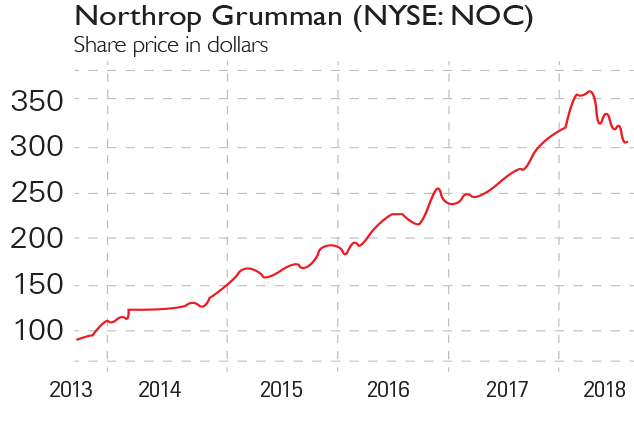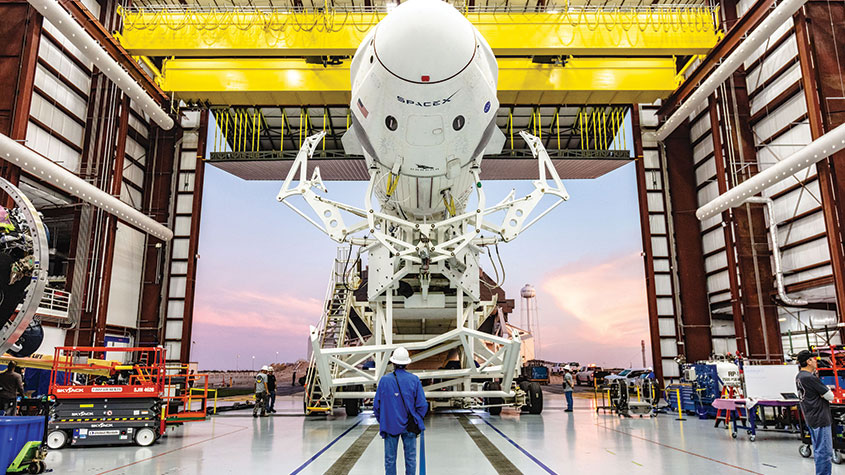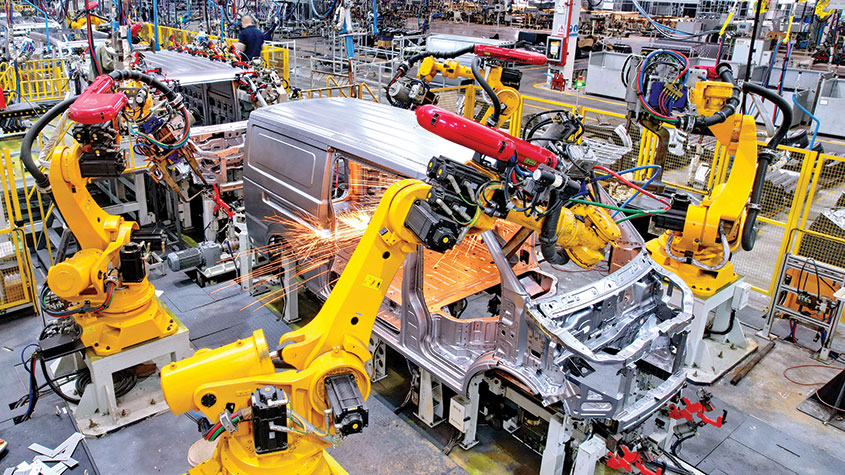Visionary investors should place their bets in the space race
It’s not just eccentric and ultra-rich tycoons heading into space. From asteroid mining to space hotels, promising profit opportunities now lie off-planet. Set your sights on the stars, says Stephen Connolly.

When White House speechwriter Peggy Noonan arrived for work on 28 January 1986, preparations for the annual US State of the Union address were largely complete, with President Ronald Reagan due on national television from the Oval Office that evening. Noonan was at her desk, helping to add the finishing touches before lunch, when everything changed.
A live CNN broadcast captured the moment that the Space Shuttle Challenger broke up, just after lift-off, with the loss of all crew, including a civilian school teacher who was due to beam back lessons from space. So devastating was the catastrophe that for the first time in anyone's memory, the State of the Union speech was postponed, and Noonan was tasked with writing a new one addressing the national loss. It was to become one of Reagan's best. Passionate, reflective and optimistic, the president hailed the bravery of space endeavour and quoted poetry, describing the astronauts as "slipping the surly bonds of earth" to "touch the face of God"'.
Tragedies such as Challenger are reminders if any were needed of the dangers of exploring and working in space, where engineering, science and people are pushed to the limit. And there have been other disasters since Space Shuttle Columbia, for example, exploded on re-entry in 2003, killing all seven crew onboard. It has left a sense of unfinished business hanging over the space race a need to keep going and to make up for what was so close but has not yet come to fruition. In his post-Challenger speech, Reagan admitted as much acknowledging the risks of space but arguing that the future belonged "to the brave". "The Challenger crew was pulling us into the future, and we'll continue to follow them."
MoneyWeek
Subscribe to MoneyWeek today and get your first six magazine issues absolutely FREE

Sign up to Money Morning
Don't miss the latest investment and personal finances news, market analysis, plus money-saving tips with our free twice-daily newsletter
Don't miss the latest investment and personal finances news, market analysis, plus money-saving tips with our free twice-daily newsletter
And Reagan was right. Over a 40-year lifespan, the $200bn-plus space shuttle programme demonstrated the huge advances that can be made when ambition and blue-sky thinking are transformed into reality, often against the odds. The fleet of five re-usable shuttles flew 135 missions, many of which laid the foundations of the International Space Station, launched ground-breaking technology such as the Hubble Space Telescope, and undertook numerous Spacelab experiments. The imagination and drive of individuals to push through failure undaunted while confidently aiming high have made the space industry what it is today and will continue to shape its future.
The billionaires with the right stuff
This is useful for investors to remember as we stand before one of the most exciting times for space exploration and the space industry as a whole, with industry veterans talking of a renaissance. Space enterprise epitomises the notion of entrepreneurialism, with visionary adventurers steadfastly finding and refining solutions in the face of adversity, always pushing through setbacks and barriers. So it is fitting that the new chapter in space exploration now under way has seen start-up private businesses move in to become distinct players in what until now (with small-scale exceptions) had exclusively been the sphere of the government and the defence industry (the US Department of Defense has a significant but mostly classified involvement in space). Far from dimmed, the pursuit of space seems brighter than ever. And it's more than just talk: big risks are being taken and big money spent. As space agency Nasa's acting administrator Robert Lightfoot said last year, "There is more going on right now in space than I've ever seen in my career".
The US government is planning to revisit the moon and put astronauts on Mars. Space tourism at scale the enduring dream is now probably closer than ever before. And there's ongoing demand for the development and launch of newer and more sophisticated satellites. At the same time, asteroid mining, manned missions to asteroids, space-based solar power, private space stations and planetary colonisation are all being pursued at various different levels. Indeed, work is even being done on highly conceptual ideas plucked from the pages of science-fiction novels, such as warp drive, cryogenic hibernation and space hotels.
The list of big investors in space reads like a who's who of modern billionaires: Tesla founder Elon Musk owns rocket company SpaceX, in which Google founders Larry Page and Sergey Brin have both invested; Amazon tycoon Jeff Bezos has his own rocket company, Blue Origin; Microsoft founder Bill Gates has backed satellite antenna technology specialist Kymeta; Facebook founder Mark Zuckerberg has invested in SETI, a project to survey the universe for signs of intelligent life; and Virgin's Richard Branson has, of course, been promising space flights via Virgin Galactic for many years now. These entrepreneurs have high profiles and pockets deep enough to get a venture off the ground and they are also all visionaries who've already successfully turned blue-sky thinking in other areas into market-beating returns for their investors.
The public backs more exploration
Of course, the involvement of private business in the space economy shouldn't be exaggerated. Governments are still the dominant players, and will be for the foreseeable future. But with that caveat in mind, it's encouraging that since 2000 more than 180 space start-ups in all have been funded. Most of those came in the last three years or so, with around $2bn-$3bn being raised by the sector each year. Overall investment since 2000 including associated debt now stands at $18.5bn from more than 500 investors, including the likes of Google, Fidelity and SoftBank. The aforementioned SpaceX and Blue Origin both of which are developing technologies for vertical take-off and landing vehicles are among a handful of space-related companies to have attracted more than $1bn-worth of investment each.
Meanwhile, public support for further space exploration is high. According to Pew Research, a US think tank, 68% of Americans hold a favourable view of Nasa, while 59% believe human astronauts are essential to the US space programme's future. A Europa survey suggests similarly positive views on space programmes across the European Union in particular of the effects these can have over coming decades in improving "down-to-earth" issues, such as energy sustainability and environmental protection.
The growing stellar economy
In all, consultancy group Bryce Space and Technology believes the space economy as a whole was worth $345bn in 2016. That value is underpinned by trends including the growing availability of private capital from new investors in the space sector; a world increasingly reliant on the transmission, receipt and processing of data; and a renewed government commitment to space on both strategic and military grounds. These underlying currents are attractive in their own right. But if we also accept the view that we're just at the start of a new, multi-generational chapter in the economic development of space, then we can begin to see a compelling investment case.
That's what the OECD, a club of developed nations, foresees. A 15-year space development cycle started this year, it thinks, which will lead to growing satellite use in mass-market products and in global monitoring; a new generation of space stations; new telescopes and unmanned, robotic missions supporting comprehensive mapping of the solar system; and a generalised increase in activity in space as new types of launchers, of various shapes and sizes, come of age.
All of this is getting industry commentators and analysts excited, with long-term targets for the space economy that are (forgive the pun) stratospheric. United Launch Alliance, a joint venture from aerospace and defence giants Lockheed Martin and Boeing to provide launch services for the US government, envisions the space economy being worth $2.7trn by 2045, by which point the venture also expects to be employing around 1,000 people actually based in space. Analysts at investment bank Morgan Stanley are a little less bullish but by 2040 they still expect the space economy to be worth at least $600bn and as much as $1.75trn. Taking a forecast in the middle of these two implies annual 5% growth from here, ahead of anticipated growth in global GDP.
Within any sector, of course, forecasting out over 20 years and beyond is more projection than estimation, and not even the most comprehensive analysis of the space economy can account for technological breakthroughs, future government defence needs, and changes in financial resources and project priorities. But there can be no mistaking the large capital commitments, determination and imagination that could, over the long term, take the sector further.
One problem with these big numbers and long-range projections, coupled with the diversity of projects from asteroid mining to space hotels is not knowing where to start. Space is overwhelming. Anything and everything seems possible. And maybe it is. But the steps we take to get there will be incremental ones. As a first step to help you get used to the industry, it is worth focusing on activities that already have active marketplaces, revenues, and even profits. At the moment these are in roughly four main areas: the satellite industry, the launch industry, insurance, and the military.
A vast expanse of investment opportunities
Let's start with satellites. This global industry generated revenues of $269bn in 2017, according to Bryce Space and Technology, which is about 75% of the current space industry's revenues as a whole. Almost half of this was from services, the vast bulk of which is related to television. Almost as big is the associated ground equipment sub-sector, which is heavily consumer-orientated think geo-spatial positioning devices such as satnav (and the related chipsets), and satellite television dishes.
Satellite technology is changing considerably: according to the OECD, while a traditional satellite might cost $1bn to build and put into orbit, small "CubeSats" that weigh less than 10kg can cost as little as $5m and be built in days or weeks, opening up space to more users for an ever-wider range of applications. Thousands of these CubeSats are expected to launch over the next five years, many of which will function as a small part of larger "constellations". Although they are still less durable and functional than their larger cousins, researchers are working on the problem.
Of course, these satellites all need to be put into orbit, which places launch-service providers at the heart of the space industry. In the past satellites were generally launched via government programmes. Now private companies such as SpaceX, with its Falcon launcher, and Blue Origin, are building market share with re-usable technology that allows for more frequent launches at a lower cost, against a background of rapidly rising satellite deployment.
Needless to say, things can go wrong an average of one in 20 satellite launches will fail according to XL, the global insurance group, although failure rates have been falling in recent years. A good number of launches aren't insured, but because the satellites are increasingly complex the average insurance claim has almost tripled in value over the past 20 years or so to around $120m. As for insurance for space tourism, this is a whole new area where appropriate products need to be developed. Alongside these activities the defence industry will continue to play a role in space, one regarded as fundamental to national security in a world of constant geopolitical tension, new technological developments, and increasing access to military hardware.
In the box below we take a look at some of the best ways to invest. For now, many of the most obviously space-related businesses are privately held, making it hard for small investors to participate. Over time this should change, particularly if there are catalysts to increase interest and demand. A public listing of Elon Musk's SpaceX would be a good example. He says he doesn't intend to go public, but don't rule it out particularly as costs mount and he needs to raise funds. In the meantime, getting involved in the space race generally means buying traditional, high-quality businesses with space-related activities alongside, and keeping a close eye on developments.
The best ways to join the space race
Pure plays on the space industry are hard to come by, with start-ups largely privately held and backed by venture capitalists. So if you want to invest in space, your best bet is to do so mainly via established businesses that happen to have space-related activities. This is no bad thing: space is risky, so it's better to reduce that risk by investing in a profitable, broad-based business that happens to have some exposure to space, rather than take a high-risk punt on an unproven business.
Aerospace and defence stocks are a good start. Lockheed Martin (NYSE: LMT) and Boeing (NYSE: BA) stand out as well as their traditional commercial aerospace and military activities, they have formed a joint venture called United Launch Alliance to provide launch services to the US government. The joint venture expects to have 1,000 staff based in space by 2045. It is entrusted with weather, communications and national security satellites, and is working on rocket development. These businesses have long track records and essentially an open line into the Pentagon. They are positively regarded by investors and offer solid double-digit profit and dividend growth, with 12- month price targets some 17%-20% above current levels.

Another defence option is Northrop Grumman (NYSE: NOC), which has established activities in satellite development and manufacturing. Its recent purchase of the well-regarded private company Orbital ATK now gives it space launch capability, so it is very much at the centre of the satellite and launch facilities sector.
Satellite group Inmarsat (LSE: ISAT) recently received an ultimately unsuccessful takeover approach from EchoStar in the US. It's a well-established group connecting those in remote places. Changing cost dynamics in the industry are bringing in new entrants who could pose a threat. But its core maritime satellite activities are more strongly insulated and the market is growing. The earnings outlook has been consistent and on balance the shares are worth tucking away long-term on any dips.
Alphabet (Nasdaq: GOOGL), parent of Google, makes this list for two reasons. Firstly, it has a stake in Musk's private launch business SpaceX, as well as in Orbital Insight (which produces analytics from satellite imagery for those involved in oil supply and agriculture), and Project Loon (which works at providing internet access to rural and remote regions). Secondly, as a dominant tech player, Alphabet stands to benefit from higher sales as satellites expand both internet availability and quality.
Get the latest financial news, insights and expert analysis from our award-winning MoneyWeek team, to help you understand what really matters when it comes to your finances.
Stephen Connolly is the managing director of consultancy Plain Money. He has worked in investment banking and asset management for over 30 years and writes on business and finance topics.
-
 RICS: Seller confidence hits new high but buyers are yet to return to the property market
RICS: Seller confidence hits new high but buyers are yet to return to the property marketThe latest Residential Market Survey from the Royal Institution of Chartered Surveyors (RICS) shows there are signs that confidence is slowly returning to the housing market
-
 'Lockdown wills’ at increased risk of legal challenge
'Lockdown wills’ at increased risk of legal challengePressures caused by the pandemic led some people to rush their wills. Now, lawyers are saying problems are surfacing that could make them invalid
-
 Invest in space: the final frontier for investors
Invest in space: the final frontier for investorsCover Story Matthew Partridge takes a look at how to invest in space, and explores the top stocks to buy to build exposure to this rapidly expanding sector.
-
 Invest in Brazil as the country gets set for growth
Invest in Brazil as the country gets set for growthCover Story It’s time to invest in Brazil as the economic powerhouse looks set to profit from the two key trends of the next 20 years: the global energy transition and population growth, says James McKeigue.
-
 5 of the world’s best stocks
5 of the world’s best stocksCover Story Here are five of the world’s best stocks according to Rupert Hargreaves. He believes all of these businesses have unique advantages that will help them grow.
-
 The best British tech stocks from a thriving sector
The best British tech stocks from a thriving sectorCover Story Move over, Silicon Valley. Over the past two decades the UK has become one of the main global hubs for tech start-ups. Matthew Partridge explains why, and highlights the most promising investments.
-
 Could gold be the basis for a new global currency?
Could gold be the basis for a new global currency?Cover Story Gold has always been the most reliable form of money. Now collaboration between China and Russia could lead to a new gold-backed means of exchange – giving prices a big boost, says Dominic Frisby
-
 How to invest in videogames – a Great British success story
How to invest in videogames – a Great British success storyCover Story The pandemic gave the videogame sector a big boost, and that strong growth will endure. Bruce Packard provides an overview of the global outlook and assesses the four key UK-listed gaming firms.
-
 How to invest in smart factories as the “fourth industrial revolution” arrives
How to invest in smart factories as the “fourth industrial revolution” arrivesCover Story Exciting new technologies and trends are coming together to change the face of manufacturing. Matthew Partridge looks at the companies that will drive the fourth industrial revolution.
-
 Why now is a good time to buy diamond miners
Why now is a good time to buy diamond minersCover Story Demand for the gems is set to outstrip supply, making it a good time to buy miners, says David J. Stevenson.